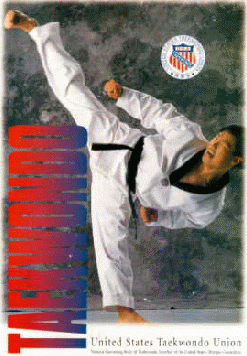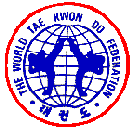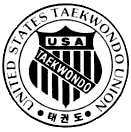 Tiger Tae-Kwon Do
Tiger Tae-Kwon Do 
Contents
![]() Master
Debbie Grimaldi Biographical Information
Master
Debbie Grimaldi Biographical Information
|
1583 South Calumet Ave. Chesterton, Indiana 46304 Telephone: (219) 921-1171 |
|
 |
TaeKwonDo is a Korean phrase made from three
parts. Tae means ‘foot' [as in to destroy with], Kwon means ‘fist'
and Do means ‘way' [in the sense of the path you should follow]. So TaeKwonDo
means ‘way of the foot and fist.' TaeKwonDo refers to a Korean fighting system which uses the hands and feet to deliver high energy impact techniques to the opponent. These techniques take the form of punches, strikes, kicks and blocks. Unlike many other martial arts, Tiger Tae-Kwon Do fights full-contact. Competitors are required to wear head gear, a mouth guard, a chest protector called a "hogu," arm and instep pads. Target area for punching is restricted to the front part of the hogu (basically, the torso area). Target area for kicking is the front and sides of the head and the hogu. In order to score a point, the strike must be on the target area and must be delivered with "trembling shock." Points do not stop the action unless there is a knockout, someone is pushed out of the ring, etc. This is completely unlike point sparring, where light or no contact is allowed and where a point stops the action until the referee resumes the fight. The United States TaeKwonDo Union, or USTU is the American Group A member of the U.S. Olympic Committee and is the National Governing Body for TaeKwonDo. It is the USTU's responsibility to select the U.S. Olympic Team and prepare them for international championships. |
Class Schedule:
Contact the School for the latest changes.
Back to Top
History of Tae-Kwon Do
The origin of TaeKwonDo can be traced back to the Koguryo dynasty, founded in 37B.C. Since mural paintings found in the ruins of the royal tombs built by that dynasty show sense of TaeKwonDo practice. TaeKwonDo was also practiced during the Sill dynasty. Silla was a kingdom found in the southeastern part of the land some 20 years before Koguryo in the north(57B.C.) Silla was famous for its Hwarang Do, the knights who trained their bodies and minds by devoting themselves to hunting, studies and training in martial art; they trained in Tae Kyon (an old name for TaeKwonDo ). TaeKwonDo retained its popularity after the Koguryo and Silla dynasties through the Koryo dynasty that was founded in 918A.D. and continued for 475 years, and through the Yi dynasty after that. In the history of Koryo, Taekwondo, which was then termed Subak , was practiced not only as a skill to improve health or as a sports activity, but it was also encouraged as a martial art of considerably high value. Taekwondo development in modern times began with the Korean liberation in 1945. After that, a number of Koreans, who were interested in Taekwondo, began trying to revitalize the traditional sport of Taekwondo. Thus, Taekwondo has grown as a unique Korean self-defense art for about 20 centuries. The popularity and enthusiasm for Taekwondo is not only domestic but worldwide as well because of the dominate superiority of Taekwondo over any other kind of self-defense arts in the world. Furthermore, its evolution and development as an international amateur sport has been fast; more than 1000 Korean instructors are teaching Taekwondo in more than 60 countries today. Taekwondo is represented by the World Taekwondo Federation. The WTF became an affiliate of the General Assembly of the International Sports Federation, by unanimous vote, at its annual meeting in Montreal, Canada on October 8, 1975.
Links to Other Tae-Kwon Do Sites
![]() Taekwondo in the 2000 Olympics
Taekwondo in the 2000 Olympics
Back to Top
Master Debbie Grimaldi Biographical Information
![]() Possess 5th Degree Black Belt in Moo Yea-Do, A Martial Arts Style combing Tae
Kwon Do and Kung Fu techniques and emphasizing defensive maneuvers.
Possess 5th Degree Black Belt in Moo Yea-Do, A Martial Arts Style combing Tae
Kwon Do and Kung Fu techniques and emphasizing defensive maneuvers.
![]() Possess 3rd Degree Black Belt in Tae Kwon Do. Instructor in Tae Kwon Do
since 1974. Moo Duk Kwon.
Possess 3rd Degree Black Belt in Tae Kwon Do. Instructor in Tae Kwon Do
since 1974. Moo Duk Kwon.
![]() Trained in Hapkido, a very practical martial art focusing on the psychology of
the street fighter. ( Haipkido's effectiveness is not based upon physical,
strength-related maneuvers, but on turning the attacker's own force upon himself).
Trained in Hapkido, a very practical martial art focusing on the psychology of
the street fighter. ( Haipkido's effectiveness is not based upon physical,
strength-related maneuvers, but on turning the attacker's own force upon himself).
![]() Instructor for a children's self -defense class ( Tiger Tae Kwon-Do),
emphasizing and incorporating aspects of physical conditioning and improving concentration
and self-discipline.
Instructor for a children's self -defense class ( Tiger Tae Kwon-Do),
emphasizing and incorporating aspects of physical conditioning and improving concentration
and self-discipline.
![]() Certified instructor for a rape prevention course prevention. Included
in the course is instruction in Hapkido & street fighting techniques.
Certified instructor for a rape prevention course prevention. Included
in the course is instruction in Hapkido & street fighting techniques.
![]() Trained Indiana Army Resource Forces in crowd control for 1996 Olympics.
Certificate of recognition for outstanding service 1996 from Army National Guard.
Trained Indiana Army Resource Forces in crowd control for 1996 Olympics.
Certificate of recognition for outstanding service 1996 from Army National Guard.
![]() Citation award 1996 by International Moo Yea-Do Federation. For
dedication and service and out-standing development of Moo yea-Do as a world spirit.
Citation award 1996 by International Moo Yea-Do Federation. For
dedication and service and out-standing development of Moo yea-Do as a world spirit.
![]() 1996 International Champion California, World Tae Kwon Do championship golden
jubilee.
1996 International Champion California, World Tae Kwon Do championship golden
jubilee.
![]() 1994 national Champion (World Tae Kwon Do Federation championship).
1994 national Champion (World Tae Kwon Do Federation championship).
![]() Member of the U.S. Tae Kwon Do Union (USTU), a nonprofit amateur sports
organization, which develops competitive martial arts programs; only martial arts
organization which sanction the U.S. Olympics and U.S. Junior Olympics.
Member of the U.S. Tae Kwon Do Union (USTU), a nonprofit amateur sports
organization, which develops competitive martial arts programs; only martial arts
organization which sanction the U.S. Olympics and U.S. Junior Olympics.
![]() Registered member of the World Tae Kwon Do Federation (WTF).
Registered member of the World Tae Kwon Do Federation (WTF).
Back to Top
Contact Information
![]()
Electronic mail address
tiger TKD@yahoo.com
Web address
https://members.tripod.com/TIGERTKD/tiger.htm
Office phone
(219) 921-1171
Back to Top
Tournament Results and Pictures
![]() Hong's Tournament,
Sept 12, 1998
Hong's Tournament,
Sept 12, 1998
![]() Future use
Future use
![]() Future use
Future use
Back to Top
Web Authoring by Pete Rivera
Comments or Suggestions about this page send to:




